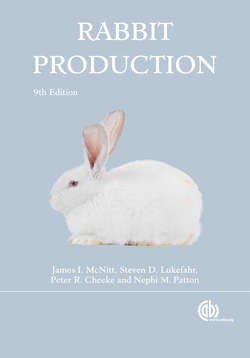Читать книгу Rabbit Production - James I McNitt - Страница 20
North and South America
ОглавлениеRabbit production continues to be a very minor component of agriculture in North America. Interest in rabbit raising has been highest during periods of economic hardship, such as in the depression of the 1930s and during World War II, when people were most interested in producing their own food.
During the 1920s and 1930s, southern California was the major site of commercial rabbit production. Several large processors operated in the Los Angeles area. After World War II, intensive industrialization of southern California occurred, and rabbit production declined sharply. One of the major rabbit processors operating in California was a company called Pel-Freez. In 1951, Pel-Freez moved to Rogers, Arkansas, and has grown to become the largest rabbit processing plant in the United States. The surrounding area, including neighboring states such as Missouri, has become the major rabbit raising area in North America. Other regions of significant production include the Pacific Coast states of California, Oregon, and Washington and parts of the Midwest. Rabbit production occurs in nearly all areas of the United States and tends to be a small-scale, part-time activity. One of the major problems in most areas is the lack of reliable markets. With the worsening global economy, there is a renewed interest in small-scale rabbit production combined with gardening so that families can stretch the food dollar.
Rabbit meat is sold mainly in large cities that have high concentrations of immigrants from European countries such as France, Italy, and Portugal, where eating rabbit is traditional. In the early 1980s a significant “health food” market for rabbit meat began to develop, because of the low fat, low sodium, and low cholesterol content of the meat and a trend away from red meats in the American diet. The abundance of food of all types in the United States suggests that rabbit meat, to become a more significant component of the diet, will have to displace some existing meat sources. This can be done by making rabbit available at a lower price than other meats, which is unlikely in the near future, or by developing specialty markets based on some unique property of rabbit meat, such as being antibiotic-free. The identification of rabbit as a “healthful” meat is a step in this direction.
In the United States, most commercial rabbitries are part-time endeavors, with breeding herds of 20 to 100 does. There are relatively few rabbitries with 300 to 600 does, and very few with 1000 or more. Economic realities of rabbit production on the American scene indicate that it likely will remain largely a part-time type of enterprise. For commercial meat production, the New Zealand White is by far the major breed, although some Californians are used. The use of rational crossbreeding programs or hybrids is also becoming more popular.
In the 1970s and 1980s, considerable interest in the Rex breed as a fur animal developed in the United States. In some cases, the promotion of Rex fur production was fraudulent or unethical, with promises of unrealistically high prices for the pelts and with very high prices charged by the promoters for the breeding stock. Many people with no knowledge of rabbit raising and little likelihood of success lost their investments. A fur industry based on the very attractive Rex fur may develop in the future.
The situation in Canada for rabbit production is very similar to that in the United States. The major areas of rabbit consumption are Toronto, Montreal, and Vancouver, where there are large European ethnic populations. In Mexico, considerable interest in rabbit production has developed as a means of increasing the protein intake of low income people. Major breeds used are New Zealand Whites, Californians, Chinchillas, and a local breed called the Criollo.
In the Caribbean region, there is some small-scale rabbit rising for local meat production, particularly on French-speaking islands such as Guadeloupe and Martinique, and the Dominican Republic. In Haiti, there was a large commercial rabbitry near Port-au-Prince, and rabbit rising is promoted in the hinterlands by a variety of organizations, including various missionary groups. In January, 2010, a devastating earthquake shook the heart of Haiti. This came on the heels of decades of economic and political degradation and four violent hurricanes in 2008. Since these disasters and the exodus of many urban residents to rural areas, the Haitian people have taken a keen interest in adding rabbit meat production to help fight against poverty and hunger. There has thus been a strong thrust toward increasing production and, within two years, over 1500 rabbit producers in four regions developed more than 1000 production units. These rabbits have directly benefited nearly 7000 participants. The rabbit is a potential means of improving the nutritional status of low income people in many of the Caribbean islands by utilizing locally grown forages and by-products.
In South America, major areas of rabbit production include Uruguay, Argentina, and Brazil, where some large rabbitries have been built. Demand for rabbit meat comes from European immigrants, particularly Italians, in the large cities, such as São Paulo and Montevideo, but meat has also been exported to other countries. Potential for growth of rabbit production in South America seems good, with the abundant forage resources and rapidly increasing human populations. There has been some Angora production, particularly in Argentina, Bolivia, and Chile.
